Tokyo - Day III
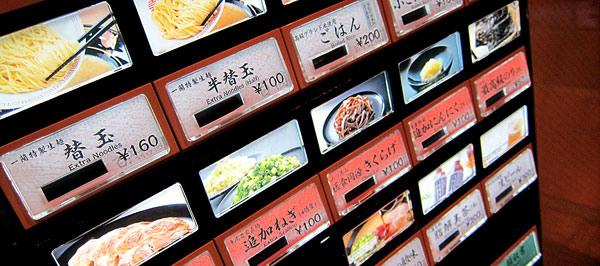 | |
| The Menu | Dominic Armato |
I'm unsure whether it was harder to get up the first or the second time that morning. Getting up at four in the morning when you crashed at two speaks for itself. Doing it again after walking four or five miles around Tsukiji and napping for two more hours has a certain Groundhog Day quality to it, but with more sushi and less suicide. Still, duty called, this time in Shinjuku.
Shinjuku is huge. And dense. And when your goal is to cover ground looking in shops, it's a little intimidating to realize that you could spend a week there and not cover everything within a half mile radius of the train station. Though it's considerably less ritzy, like Ginza, Shinjuku is anchored by massive department stores, and first on our hit list was Isetan, which turned out to have what might have been the most impressive food department of the trip.
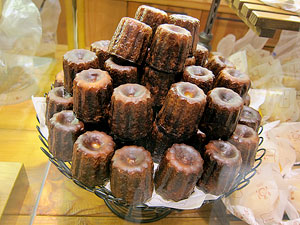 |
||
| Canelés | Dominic Armato | |
Of course, they all start to run together after a while. But in terms of both size and quality, it was really something to behold. While perusing the fish department, my father was a little taken aback by one of our discoveries. He's has had his fair share of odd foodstuffs. Perhaps even more than me (exotic game restaurants in China can throw some serious curveballs). But upon encountering an orange-sized squishy grey mass that looked almost like a brain, he asked if I knew what it was. "Cod sperm," I replied, "Highly regarded delicacy. It's in season right now." He didn't reply, but the "oooooookay" look said it all, I think. On the less challenging end of the spectrum, one thing that's frequently overlooked by food writers, I think, is the availability of astounding pastry in Japan. The cultural obsession with quality and perfection extends to foreign cuisines as well, and though cakes and chocolates and pastries are, in the grand scheme of things, relatively recent imports to Japan, these food departments are filled with scores and scores of counters selling some of the most amazing cakes, cookies and candies you've ever seen. I'm not a big sweet tooth. But I know a good canelé is tough to come by. And by god, these were dynamite, with a thin but crisp crust, tender custard inside, and fabulous flavor. A cultural commitment to precision was never put to better use.
After a few hours of wandering the area, checking out a wide variety of stores (Shinjuku's offerings are rather more diverse than Ginza's), it came time for lunch, and here's where I realized that I'd completely fallen down and didn't have a restaurant scouted in the immediate vicinity. The closest spot on my hit list was a mile away, and we didn't want to lose too much time. Then, in serendipitous fashion, I realized that we were standing directly across the street from one of my target ramen chains that I hadn't even realized was there.
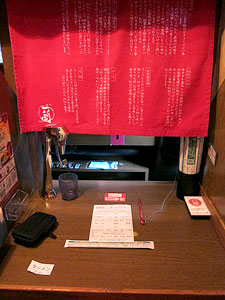 |
||
| The Booth | Dominic Armato | |
Ichiran is one of the ramen stalwarts that has name recognition in the States. Part of this is, no doubt, due to the running gag that has become the New York outpost, on the verge of opening for more than four years. But while Ichiran's soup is widely praised, what seems to generate ink is the way it embodies cultural quirks, and leads people to smile, shake their heads and think "Only in Japan." The experience starts out front, where a coin and bill op vending machine pictures the menu in full color buttons. You select what you'd like, insert some coins or bills, and receive a small paper ticket. You then proceed inside, where a diagram of the restaurant lit with color-coded light bulbs indicates which seats are taken, which are vacant, and which are in the process of being cleaned. The reason for this is that every seat at Ichiran is a private booth of sorts, separated from its neighbors by wooden partitions, and hidden from the kitchen by a small curtain, save for a few inches at the bottom where food can be passed through. When you sit down, waiting for you is a plastic cup and personal water dispenser, chopsticks, some assorted Ichiran literature, and most importantly a ballot whereon you can customize your bowl -- firmer or softer noodles, richer or lighter broth, heavier or lighter garlic -- before pushing the red button that will summon an attendant to take your ballot and ticket. Of course, you never see more than this attendant's hands and hear his disembodied voice. Other accounts I'd read led me to believe that Ichiran was silent as a tomb, save for the slurping of others in the room. But a synthesized shamisen plinking out Top 40 tunes makes for an even more surreal atmosphere, and the attendants, though never fully seen, are quite vocal and not shy about their volume. A few minutes later, two disembodied hands set your bowl in front of you, the voice says something very earnest and gracious, the attendant slides down a shutter, and it's just you and your ramen.
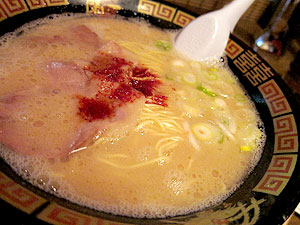 |
||
| Ramen | Dominic Armato | |
And I've got to say, this is some damn fine ramen. The experience may be one of the reasons Americans love to write about the place, but what's inside the bowl is the reason there are 31 locations and legions of devoted fans. The broth is an unusually clean and sweet tonkotsu, made by boiling pork bones for an extended period of time (perhaps a day or two), but relatively free of some of the impurities and funkier characteristics that often result. In its non-customized state, it's plenty rich for my tastes, and though the garlic is present I'm barely getting any seafood if it's there... this is all about the pork. The noodles are a very thin Hakata-style, approaching a vermicelli thickness, and though they possess an impressive bite for so thin a noodle, I find myself pining for the aggressive chew of Gogyo's, two days prior. Of course, a little customization might fix that, I don't know. The lone toppings are a couple slices of pork, a smattering of sliced scallions, and a dollop of house chili sauce in the center of the bowl. The chili sauce, though wet, has a very pronounced dry chili flavor, and as it mixes into the soup it brings a nice warm burn to the back of the throat. The first couple of spoonfuls strike me as very good, but it's one of those soups where the deeper you get into the bowl, the more the flavor builds. By the end, I'm loving it, and though extra noodles are readily available by marking your chopstick sleeve and pressing the red button again, I'm as into the soup as I am the starch. I finish it off sated and happy. It's not a religious experience. But for somebody who's had precious little ramen in Tokyo, it's one of the best bowls I've tasted. Something I'd kill for back home.
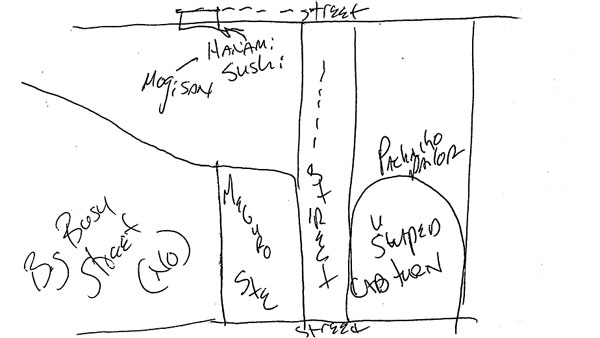 | |||
| The Map | Dominic Armato | ||
By the time dinner rolled around, I'd decided it was time to embark on a quest. My friend Josh, of Posh Restaurant, worked for a few years in Japan. So before my departure, over whiskey one evening, he grabbed a table check, flipped it over and began to map out the location of his favorite sushi bar in Tokyo while excitedly describing the directions.
"When you're in Meguro station, you can exit on two sides. On one side, there's a busy street with a canyon of huge buildings. It looks like Inception. Don't go that way. On the other side, there's a circular taxi drive, and a huge pachinko parlor..." In the end, he captured it remarkably well, and a good thing too, because Hanami Sushi completely eluded my Google-fu, and as we arrived at Meguro Station I didn't even know if it was still in existence.
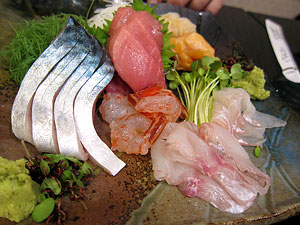 |
||
| Sahimi | Dominic Armato | |
But there it was, precisely as described, a small, modern sushi bar that put out some very refined fish while still maintaining a neighborhood vibe. Hanami doesn't seat much more than a dozen people at a time, and on this night the crowd had a decidedly executive vibe, relaxing and having some sake and good food after work. The room's overseen by Mogi-san, an itamae with a warm disposition, permanent smile and talented hands. Through his staff, we managed to communicate that Chef Joshua had sent us, showing an iPhone photograph to jog his memory (it had been a number of years since Josh left), and a lengthy round of awkward but enthusiastic bowing and handshaking ensued. Sadly, the bar was full. But we parked at one of the tables, and put ourselves in Mogi-san's hands.
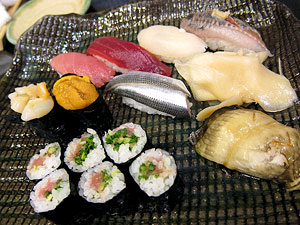 |
||
| Sushi | Dominic Armato | |
What followed was fish, of fabulous quality, skillfully prepared and impeccably presented. I did an extremely poor job of taking notes, and I'm left more with impressions than specifics, but I can state that yes, it tasted as wonderful as it looks. I do recall some deep and complex mackerel, fabulously light and sweet shrimp, and chutoro with a flavor far more robust than it looked like it should have had. This was followed by a round of sushi of similar excellence, including more dynamite mackerel, sweet magurozuke, and rich toro. A small roll made an appearance -- negi hamachi, I believe? -- sharp scallions accenting smooth yellowtail. And a man after my own heart, Mogi-san included both uni and hotate, both so fresh that they sang with natural sweetness. The two plates constituted a stunning array of raw fish, and all the more impressive was that it was coming from what could have been just another neighborhood joint. Either Josh found himself a gem, or this is just how it is in Japan.
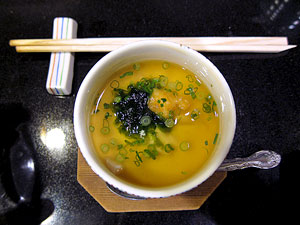 |
||
| Shirako Chawanmushi | Dominic Armato | |
When our server came over to ask if we'd like some chawanmushi, my heart leapt. I love chawanmushi, and was excited to see what it could be in such capable hands. Chawanmushi is a steamed egg custard, usually seasoned with dashi and perhaps soy and mirin, and it exceptionally delicate in both flavor and texture when done well. This was more than done well, bordering on ethereal, a perfect texture and subtle dashi flavor yielding a special surprise below. Our morning's discussion proved to be serendipitous, as this was shirako chawanmushi. I'd get my first taste of cod sperm. Had I known I'd be tasting it later in the evening, I would have gotten a good photo of the raw ingredient in the morning, but there's a good image here (even though I hate to indirectly endorse the "Oooooooo, these foods are bizarre!" approach). While I realize it's a shudder-inducing thought to many (hey, the older generation of Japanese feel the same way about us eating cheese), it's rather innocuous on the other side of the mental leap. Delicate is the operative word, with an ever so slightly briny flavor and soft texture that couldn't be more perfectly suited to chawanmushi. I really, really enjoyed this.
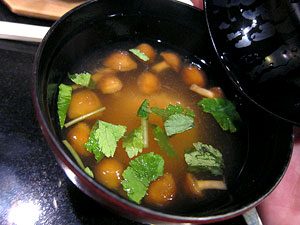 |
||
| Beech Mushroom Miso Soup | Dominic Armato | |
We closed with a dish I usually think of as an opener, but particularly in the wintertime, a hot cup of miso soup is a delightful finish and I wonder why we don't see it on the tail end more often. This cup was enhanced by some wonderfully delicate beech mushrooms, their soft, spongy texture absorbing the soup and adding a delightful little squish -- can one say that in a positive context? -- to a comforting finish. I was really impressed by Hanami, mostly by Mogi-san's sensitivity in dealing with delicate ingredients. So much of this meal dealt with subtleties that would have been completely lost in the shuffle when handled by most chefs. But these preparations were just restrained enough to let the more delicate ingredients take center stage, and that's something that takes a lot of culinary wisdom and an experienced hand. We expressed our gratitude to Mogi-san, who expressed his gratitude to us for coming. Business cards were traded. Promises to say hello to old friends were extended. And we left to make our way back to the hotel. It had been one heck of a day for sushi and sashimi, though I feel compelled to note that it also drove home just how exceptional a restaurant ShinBay is, and how lucky we are to have it in Phoenix.
But there was no way I was going to let the day go at that. With roughly twelve hours until we'd be leaving for the airport, I wasn't going to let a minute go to waste. I'd been enjoying the ramen so much, I resolved to squeeze in two more bowls... one for the next morning, and one for a nightcap. I was craving miso ramen, of the non-burnt variety, and I'd read of a particularly intense bowl in Shinjuku. Though it was a weeknight, Shinjuku seemed like an area that might also yield some good street eats, so I committed to the cab fare home and hopped on the Metro just as it was getting ready to shut down for the evening.
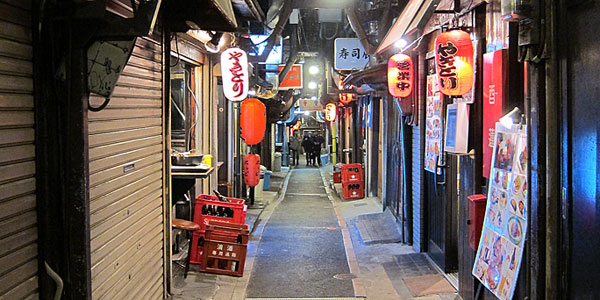 | |||
| Piss Alley | Dominic Armato | ||
My target was a ramen shop called Kotatsu, and since they were open until 5:00 AM, I decided to leave them for last and see if I could grab some street eats on the way. I couldn't even remember the last time I'd had good yakitori, and Shinjuku station is directly adjacent to one of the most famous yakitori stops in the world. The colorfully nicknamed Piss Alley is tucked away against the tracks on the northern end of the station, a narrow stretch of pavement a couple hundred yards long, lined with late night yakitori eateries and drinking establishments. I had visions of another Ebisu Yokocho, but focused solely on chicken parts, though if I'd known what I was in for I probably would have just gone back to Ebisu instead. I was disappointed to discover that even shortly after midnight -- what I'd hardly consider a late hour for a part of town known for its nightlife -- Piss Alley was mostly shuttered. I counted five joints open, and a couple of them weren't even yakitori joints. Of the yakitori stands, one was giving me a bad vibe. The second was open to the street, but all of the streets were taken and it looked like they were shutting down. But one joint on the far south end seemed to be going strong, and a crowd of six or seven businessmen were loudly carousing within. This seemed like a good bet.
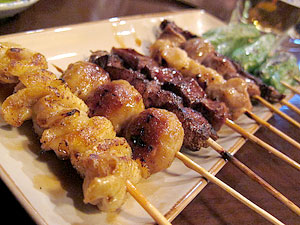 |
||
| Yakitori | Dominic Armato | |
It was tiny and dark, and though I suppose some might call it dingy, it struck me more as full of character, like a good dive bar. Translated menus are always helpful, but some let off an especially touristy vibe, and this was one of them. I started to get a little worried, but foraged ahead anyway, ordering their basic yakitori assortment. It was only after 5-10 minutes of waiting that I noticed the tableful of businessmen -- still loudly laughing and joking -- wasn't actually eating any food. This was about the time I started to think I'd made a mistake. And when the food finally arrived, half an hour after I ordered, that notion was confirmed. Oh, it looks nice enough in the photo... skewers of chicken thigh, tsukune, liver, gizzard and more. But what it lacked was flavor, texture and sizzle. The meats were dull, underseasoned, and lent the impression that they'd been slowly warmed over the end of the evening's dying embers rather than a hot, smoky fire. Oh, there was some char. I don't think they were re-warmed or anything like that. But this was lackluster at best. Strike one for late night dining.
Completely bummed, I revised my plan. The area seemed a whole lot deader than I expected, and fearing a bust of an evening, I decided to head straight to Kotatsu to make sure I had a good stop under my belt. Apparently, being a single male tourist walking through this part of Shinjuku late at night makes you a target for the night club point men, who will do everything short of tossing a sack over your head and dragging you back with them to get you in the door. They're persistent. And annoying. And I can't believe they're successful enough to merit their continued operation. But after fending off no fewer than a dozen, I arrived at... where Kotatsu was supposed to be. One of the fellows who'd been following me for a block and a half thought he saw an opening.
"What are you looking for, man?"
"A restaurant."
"Maybe you're looking for mine!
"I doubt it."
"Well, what's it called, maybe I can help you."
"Kotatsu."
"Ah, sorry, man, Kotatsu closed in December."
I wouldn't have taken his word for it. I've no doubt he would have flat-out lied to get me into his bar/club/restaurant/whatever. But there was no denying that I was standing right in front of where Kotatsu was supposed to be, and there was no Kotatsu. Not only was this strike two, but the yakitori place had taken so long that I'd never make it to my backup ramen shop before closing.
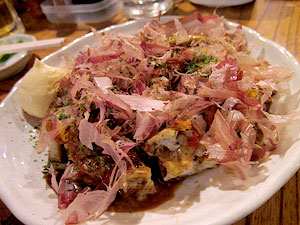 |
||
| Okonomiyaki | Dominic Armato | |
Frustrated by a string of bad luck that was rapidly turning my last late night in Tokyo into a total bust, I realized I was just a couple of blocks away from Golden Gai, a section of Shinjuku known for its quirky vibe and late night sensibilities. I resolved to give it one last shot before throwing in the towel. Golden Gai is quirky, all right, a patch of land about the size of a football field packed with tiny, ramshackle two-story buildings and narrow alleys. Music clubs and dive bars were abundant, some shuttered for the evening, others filled with late night patrons having a beer and listening to music, both recorded and live. I weaved my way through the deserted aisles, peeking into a club or two, not seeing anything in the way of eats. And when I was nearing the point of surrender, I caught a whiff of something and my head whipped around. When in doubt, follow your nose. And my nose led me to a tiny, tiny little eatery, eight or ten feet square on the ground floor of what amounted to little more than a hovel. But the fellow manning the open kitchen moved with economy and purpose, an obviously seasoned hand, and the smells coming from his griddle were intoxicating. A tiny counter seated five, and on the corner was one open seat. Clearly, it was waiting for me.
There's a feeling captured so well by the film Lost In Translation, of being dazed, out of time, surrounded by people yet completely disconnected from them on every level, and that's the feeling I had while sipping a beer and fighting fatigue in this dive of an okonomiyaki joint. On my right, a couple that had obviously been carousing all night were getting progressively drunker and drunker and closer and closer. On my left, two tiny young women in formal kimonos(!), hair artfully sculptured and faces carefully painted, were putting away enough food to feed four teenage football players and energetically chatting about something that was obviously very, very exciting. It was a surreal scene, but a surreal scene with okonomiyaki, which thankfully didn't require a whole lot of cultural knowledge to order. I love okonomiyaki, and there's no better time for it than 2:30 in the morning. An egg and batter pancake, in this case packed with vegetables and a shocking amount of bacon, griddled up hot, served alongside a golf ball-sized dollop of Kewpie mayonnaise and topped with sweet okonomiyaki sauce and a pile of bonito flakes dancing and waving in the rising heat. This is booze food, late night fare, big and greasy and sweet and salty and so completely fabulous. I've had better, but this was pretty darn good, and if I had even the slightest idea of the name of the place, I'd note it here for posterity. But it will forever remain a mystery, a place out of time, and I've no doubt that when I return I'll walk the alleys of Golden Gai saying to myself, "Man, I could have sworn it was rigt here." Though disappointing, the evening wasn't a total loss after all. As I stumbled out, I could barely stand and I figured I was unlikely to find a better nightcap than that. I wanted to get a little bit of sleep, anyway. Just one morning left.
| Tokyo - Day I | Tokyo - Day II | Tokyo - Day IIS | Tokyo - Day III | Tokyo - Day IV |
|
|
|||||||||||||||||||||||||||||||||||

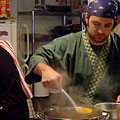
Comments